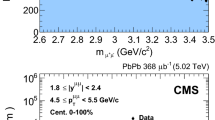Summary
The neutron spectrum, the neutron asymmetry with respect to muon spin direction, and the neutron polarization are calculated as functions of neutron energy for μ-meson capture in deuterium. The total capture rate and the dependence of the rate on the hyperfine state of the mesic atom are given and compared to approximate expressions. The dependence of the observations on the amount of Fermi or Gamow-Teller coupling and on the presence of an effective pseudoscalar coupling is displayed.
Riassunto
Si calcolano lo spettro dei muoni, l’asimmetria dei neutroni rispetto alla direzione dello spin dei muoni e la polarizzazione dei neutroni, come funzioni dell’energia dei neutroni per la cattura dei mesoni μ in deuterio. Si danno il rateo totale della cattura e la sua dipendenza dallo stato iperfino dell’atomo mesico e si confrontano con le espressioni approssimate. Si mette in evidenza la dipendenza delle osservazioni dalla quantità di accoppiamento Fermi o Gamow-Teller e dalla presenza di un accoppiamento pseudoscalare effettivo.
Similar content being viewed by others
References
I. S. Shapiro, E. I. Dolinsky andL. D. Blohincev:Nucl. Phys.,4, 273 (1957);K. Huang, C. N. Yang andT. D. Lee:Phys. Rev.,108, 1340 (1957).
L. Wolfenstein:Nuovo Cimento,7, 706 (1958).
J. Bernstein, T. D. Lee, C. N. Yang andH. Primakoff:Phys. Rev.,111, 313 (1958).
A. Rudik:Dokl. Akad. Nauk SSSR,92, 739 (1953);H. Primakoff:Proc. of the Fifth Annual Rochester Conference on High Energy Physics (New York, 1955), p. 174 and private communication.
L. Wolfenstein:Nuovo Cimento,8, 882 (1958).
T. D. Lee andC. N. Yang:Phys. Rev.,104, 254 (1956), Eq. (A.1). The two-component neutrino theory is obtained by settingG′ l =G l for left-handed neutrinos andG′ l = −G l for right-handed ones. For parity-conserving processes, the two-component neutrino theory is identical with the old parity-conserving interaction provided Eq. (A.1) is divided by √2, which we have done.
Eq. (1) of Ref. (2) should be multiplied by a factor (1 +v/M)−1.
Tables of the integralsI ij andI′ ij are available from the authors.
K. M. Watson andR. N. Stuart:Phys. Rev.,82, 738 (1951).
H. A. Bethe andC. Longmire:Phys. Rev.,77, 647 (1950).
J. M. Blatt andV. F. Weisskopf:Theoretical Nuclear Physics (New York, 1952).
R. H. Phillips andK. M. Crowe:Phys. Rev.,96, 484 (1954).
The absolute rate is obtained by settinga FF = 2G 2 anda GG - 2/3a GP = 2G 2, whereG is the experimental Fermi coupling constant (11) of β-decay,G = 10−5/M 2. The curves omit the high-energy tail of the neutron spectrum which extends to 50 MeV (=1/2(μ -D)).
This value has been emphasized byR. P. Feynman andM. Gell-Mann:Phys. Rev.,109, 193 (1958).
H. Überall:Nuovo Cimento,6, 533 (1957).
We use the coupling constants ±G F =G, G G =G, C P = ±9G, and consistently neglect |C P|2 terms. (G = 10−5/M 2). With these coupling constantsw decay/w H equals 4·103 for the caseF±G rather than 2·103 as has often been stated (13).
See, for example,J. L. Lopes:Phys. Rev.,109, 509 (1958). In this case, the difference of a factor 2 is mainly due to Lopes’ neglect of corrections of the orderμ/M.
Author information
Authors and Affiliations
Additional information
The numerical calculations were performed on the Paris IBM-704 electronic computer, and the assistance of MissF. Rattaud is greatly appreciated.
Rights and permissions
About this article
Cite this article
Überall, H., Wolfenstein, L. Capture of μ-mesons in deuterium. Nuovo Cim 10, 136–149 (1958). https://doi.org/10.1007/BF02859612
Received:
Published:
Issue Date:
DOI: https://doi.org/10.1007/BF02859612




